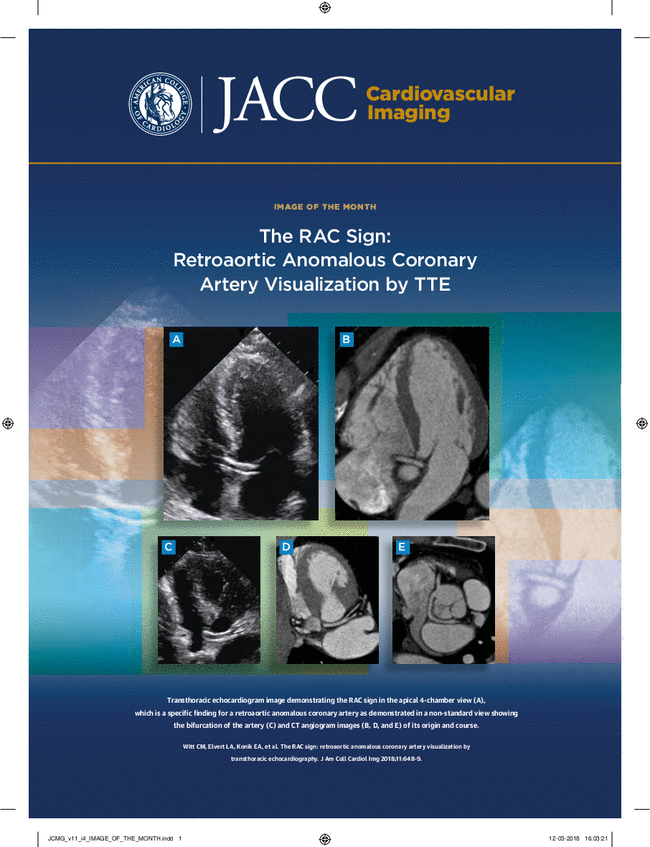经治疗的转甲状腺素淀粉样心肌病的一系列骨显像表现的临床相关性尚不确定。
IF 15.2
1区 医学
Q1 CARDIAC & CARDIOVASCULAR SYSTEMS
引用次数: 0
摘要
背景:锝-99m标记的3,3-二磷酸-1,2-丙二羧酸(99mTc-DPD)闪烁显像是经验证的甲状腺素淀粉样心肌病(atr - cm)非活检诊断算法的关键部分。随着新型atr - cm疾病改善疗法的出现,人们对建立DPD扫描作为治疗反应指标的效用产生了浓厚的兴趣。目的:作者进行了一项回顾性多模态成像研究,以确定99mTc-DPD在跟踪atr - cm治疗反应中的效用。方法:纳入来自英国国家淀粉样变性中心接受淀粉样特异性疾病修饰治疗(DMT)并在治疗前后进行99mTc-DPD/单光子发射计算机断层扫描的atr - cm患者。在基线和随访时测量心肌注射剂量百分比(PID),这是一种建议的心脏淀粉样蛋白负荷的闪烁图指标。将该变量与基线的变化与其他有效的疾病严重程度生物标志物进行比较。结果:66例接受DMT治疗的atr - cm患者接受了连续99mTc-DPD扫描。随访时,99mTc-DPD扫描间隔的中位时间为27.5个月(Q1-Q3: 21.9-33.1个月),99mTc-DPD扫描显示的心肌PID比dmt前平均降低1.5±1.5%。随访时PID的变化与超声心动图、生化或心脏磁共振参数的变化之间无统计学意义的相关性。66例患者中有28例(42.4%)随访99mTc-DPD显像改善,尽管疾病进展。结论:我们的研究表明,随访时99mTc-DPD摄取的减少与atr - cm治疗反应的许多既定生物标志物之间的相关性较差。接受DMT治疗的atr - cm患者的DPD摄取变化应谨慎解释。本文章由计算机程序翻译,如有差异,请以英文原文为准。
Uncertain Clinical Relevance of Serial Bone Scintigraphy Findings in Treated Transthyretin Amyloid Cardiomyopathy
Background
Technetium-99m–labeled 3,3-diphosphono-1,2-propanodicarboxylic acid (99mTc-DPD) scintigraphy is a critical part of the validated nonbiopsy diagnostic algorithm for transthyretin amyloid cardiomyopathy (ATTR-CM). With the advent of novel disease-modifying therapies for ATTR-CM, there is intense interest in establishing the utility of DPD scans as an indicator of treatment response.
Objectives
The authors conducted a retrospective multimodality imaging study to determine the utility of 99mTc-DPD to track treatment response in ATTR-CM.
Methods
ATTR-CM patients from the United Kingdom National Amyloidosis Centre who were receiving amyloid-specific disease-modifying therapy (DMT) and underwent pre- and post-treatment 99mTc-DPD/single-photon emission computed tomography–computed tomography scans were included. Myocardial percentage injected dose (PID), a proposed scintigraphic indicator of cardiac amyloid burden, was measured at baseline and follow-up. Change from baseline in this variable was compared with that of other validated biomarkers of disease severity.
Results
A total of 66 patients with ATTR-CM who received DMT underwent serial 99mTc-DPD scans. At follow-up, with a median time between 99mTc-DPD scans of 27.5 months (Q1-Q3: 21.9-33.1 months), there was a mean reduction from pre-DMT myocardial PID on 99mTc-DPD scintigraphy of 1.5 ± 1.5%. No statistically significant correlation between the change in PID at follow-up and change in echocardiographic, biochemical, or cardiac magnetic resonance parameters was identified. Discordance in which there was an improvement on follow-up 99mTc-DPD scintigraphy despite disease progression was observed in 28/66 patients (42.4%).
Conclusions
Our study indicates a poor correlation between reduction in 99mTc-DPD uptake at follow-up and numerous established biomarkers of ATTR-CM treatment response. Changes in DPD uptake in ATTR-CM patients receiving DMT should be interpreted with caution.
求助全文
通过发布文献求助,成功后即可免费获取论文全文。
去求助
来源期刊

JACC. Cardiovascular imaging
CARDIAC & CARDIOVASCULAR SYSTEMS-RADIOLOGY, NUCLEAR MEDICINE & MEDICAL IMAGING
CiteScore
24.90
自引率
5.70%
发文量
330
审稿时长
4-8 weeks
期刊介绍:
JACC: Cardiovascular Imaging, part of the prestigious Journal of the American College of Cardiology (JACC) family, offers readers a comprehensive perspective on all aspects of cardiovascular imaging. This specialist journal covers original clinical research on both non-invasive and invasive imaging techniques, including echocardiography, CT, CMR, nuclear, optical imaging, and cine-angiography.
JACC. Cardiovascular imaging highlights advances in basic science and molecular imaging that are expected to significantly impact clinical practice in the next decade. This influence encompasses improvements in diagnostic performance, enhanced understanding of the pathogenetic basis of diseases, and advancements in therapy.
In addition to cutting-edge research,the content of JACC: Cardiovascular Imaging emphasizes practical aspects for the practicing cardiologist, including advocacy and practice management.The journal also features state-of-the-art reviews, ensuring a well-rounded and insightful resource for professionals in the field of cardiovascular imaging.
 求助内容:
求助内容: 应助结果提醒方式:
应助结果提醒方式:


